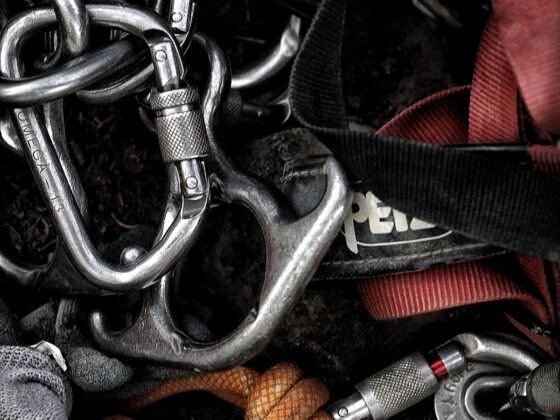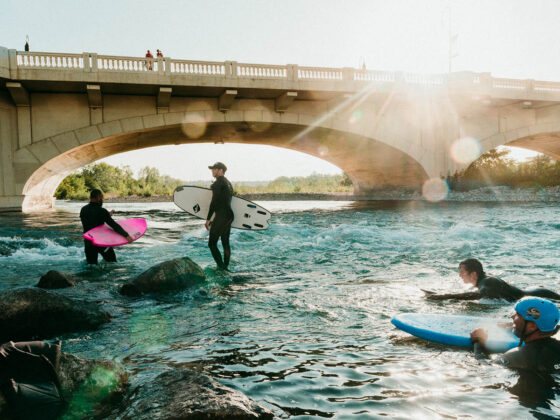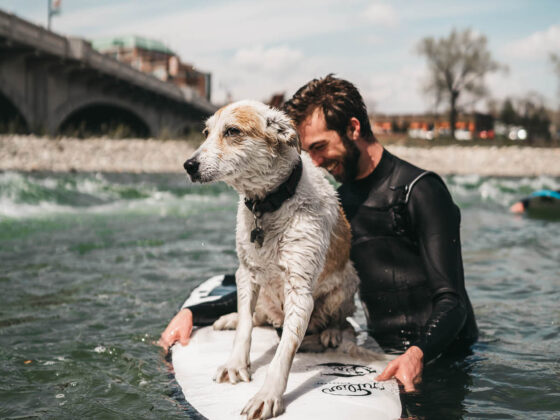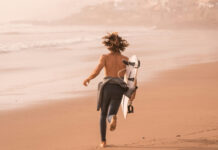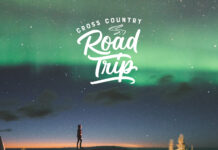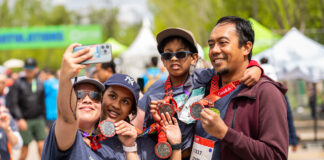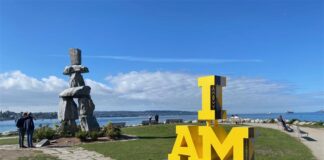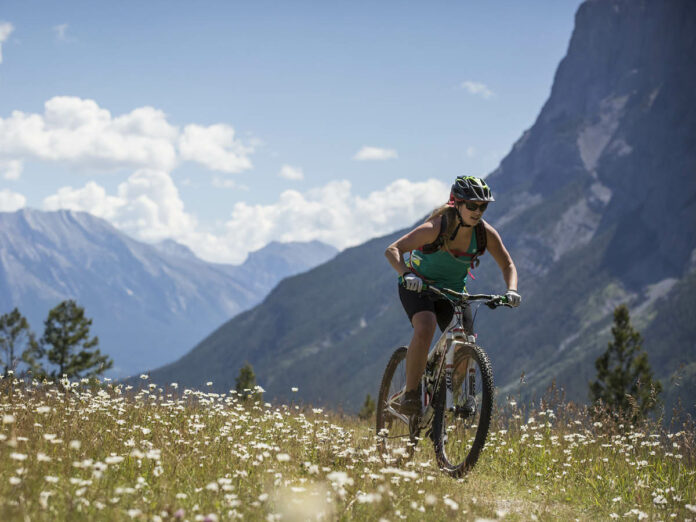
This summer, Albertans have been encouraged to explore their own backyards and with a wealth of assets from rivers and lakes to mountains and plains, there is no shortage of activities to enjoy.
Now, more than ever, it is crucial that people plan ahead. Before heading out, know where you’re going to park, how best to get around, how to stay safe and the status of the places you plan to visit. Be self-sustainable and bring a COVID-19 kit of hand sanitizer, water and supplies, as fewer services are available than normal.
It’s a new norm this year so we all need to realize that while many businesses are open, they may be operating differently. Call ahead or check the business’ website before arriving and consult Alberta Health Services guidelines about travelling.
Get Active in the Mountains
1. Paddleboarding
Boasting icy waters year-round, you’ll want a hot day to paddleboard on a scenic mountain lake. Banff National Park has a plethora of lakes to choose from including Two Jack, Lake Minnewanka, Lake Louise and Morraine Lake. Various Banff and Calgary companies offer paddleboard rentals and inflatable boards are a good option. They fold up relatively small for easy transport and are inflated when you’re ready to go. Parking at Lake Louise fills up quickly to get there early to grab a spot.
Paddleboarding will give your whole body a workout and is especially good for core muscles and balance. If you want to try moving water, the Bow River in Calgary is the closest option. However, unless you rent from a company offering a shuttle, you’ll need a vehicle at both your put-in and take-out spots.

2. Via Ferrata at Mt. Norquay
If you’re looking for an exhilarating adventure, check out the Via Ferrata at Mt. Norquay in Banff. Italian for ‘iron road,’ the Via Ferrata will give you a mountaineering experience while being safely clipped into a fixed cable on the rock face. Wearing a safety harness and helmet, you’ll ascend on iron rungs and steps drilled into the rock.
There are four different routes on the Via Ferrata, varying in distance from the Explorer which takes about two and a half hours, covers 1 km and climbs 145 metres to the Summiteer which is a six hour commitment, covers 3.2 km and climbs 360 metres. Each one starts at the top of the chairlift – a fun ride on its own! All involve climbing while using the cables, steps and ladder rungs, and then descending on a hiking trail. The routes are led by a ACMG certified mountain guide who will keep you safe at all times.
I tried the three-hour Ridgewalker route and thoroughly enjoyed it. It was physical, but not too difficult – a person in average shape could do this. And you don’t need any experience to try it. However, there was quite a bit of exposure to cliff faces, swinging bridges and lots of climbing. You are always clipped in to the cables via your harness, so there is no chance of falling. However, if you’re scared of heights, this might not be for you.
As you get up high, the views of the town of Banff and the surrounding mountains and valleys open up in front of you and are spectacular. And you’ll feel a real sense of achievement as you gain the final summit of the route! On the hike down we encountered a large herd of mountain sheep with a few cute babies in the mix. We saw playful marmots too.
The maximum group size right now due to COVID-19 is four, unless it’s a family group, then the largest would be eight. The Via Ferrata is a great introduction to the mountains and a thrilling experience – especially for visitors who haven’t been exposed to climbing or mountaineering. It’s a safe way to challenge yourself and try something new.
3. Cycling the 1A Highway at Banff or the Lake Minnewanka Loop
“If you really want to interact with the mountains, cycling is a wonderful way to do it,” says Gary Millard, president of Bike Calgary. And now is your chance to get out and enjoy some spectacular scenery sans cars.
Currently, the 1A highway between Banff and Castle Mountain junction is closed indefinitely to traffic but open to cyclists. It is also newly paved making the ride even more of a dream! Johnson Canyon is 17 km from the start of the highway and you can stop there for lunch or coffee before continuing a further six km to the Castle Junction and turning around. If you opt to keep riding to Lake Louise, this portion is open to traffic. The elevation gain from Highway 1 to Johnson Canyon return is 302 metres and you’ll be faced with moderate hill climbs in both directions.
Parks Canada says there is limited parking at the Highway 1/Highway 1A junction and users need to respect all parking signs. They recommend parking at the Banff Train Station or Fenlands Parking lot in the town of Banff and cycling to the start of the 1A along the multi-use pathway. This will add several kilometres to your trip. Also, beware of wildlife. Grizzly, black bears and mountain sheep have been seen along the route.
The Lake Minnewanka loop is another option for cyclists although you’ll be sharing the road with vehicle traffic so take extra precautions here.
If you don’t have a bike but still want to ride this route, there are a number of bike rental shops in Banff. Check them out!
4. Caving in Canmore
Instead of hiking to the top of a mountain this summer, try heading inside by exploring Rat’s Nest Cave in Canmore. Canmore Cave Tours will take you deep into the heart of Grotto Mountain to experience a day in the life of a cave explorer.
“The tours are moderately strenuous,” explains Caving in Canmore’s office manager Lenora Barnes. “There is a steep hike up mountainous terrain – basically a dry riverbed. You’ll gain 200 m over a 1 km trail to reach the mouth of the cave,” she says.
During your tour, Barnes says visitors will be crawling, climbing, scrambling and ‘scootching’ – a technical caving term for moving forward while sitting on your butt! Visitors can choose a shorter four-hour tour or a longer six-hour adventure and learn about the natural history of the Rat’s Nest Cave system. The longer tour is more strenuous and includes a 20 m rappel drop and some narrow passages including the ‘Laundry Shoot’ where guests must wriggle through feet first, on their back.
Barnes says the tours are completely flexible and that if a visitor changes their mind while in the cave, the guides can accommodate with an alternate route. The company provides all safety equipment including helmets, kneepads, gloves and overalls and everything is sanitized as per COVID-19 protocols. Masks are mandatory in the cave and will be provided.

5. Hiking in Waterton National Park
While other national parks may be full of Albertans who want to experience the great outdoors, down in Waterton, situated on the Alberta/US border, things are quieter. That makes it a great hiking destination where you’ll see stunning views of both mountains and prairies, amazing wildflowers and wildlife too.
Kelly Baker, general manager and guide at Tamarack Adventures has lived in Waterton her whole life and knows the area inside and out.
“There are over 200 km of hiking trails in the park,” Baker says, “and there’s something for everyone from easy 1 km hikes to overnight trips. We are known as a hiking destination. Hiking is great for getting outside and also for social distancing.”
Baker says this summer their guided hikes will be limited to five clients, down from 10, which will make for a more intimate experience. One of their popular activities is called The Fine Art of Hiking which combines the hike with an art session where clients paint. Baker has a degree in Fine Arts and says the scenery in Waterton is inspiring for artists.
Two of Baker’s favourite hikes include the Carthew-Alderson, a one-way 20 km hike from Cameron Lake to the townsite. It’s a local favourite and rated as one of the most scenic hikes in the park. The other is Goat Lake, a 14 km return trip to an alpine lake.
“It’s a very doable day hike,” Baker says, “It starts on out the Snowshoe Cabin Road and you end up at a beautiful, little blue green lake.”
Waterton is a two and a half hour drive south of Calgary which is about the same as driving to Lake Louise.
“It’s not as far away as you might think,” Baker says.
For overnight stays, park campgrounds are now open and there is also a private campground nearby. In addition, there are hotels both in Waterton Village and in nearby Pincher Creek.
“A lot of people make Pincher Creek their base because that puts them right in the middle of three parks – Waterton, Beauvais Lake Provincial Park and Castle Park,” says Baker.
If you choose to stay in Waterton Village, the main street has been closed to traffic making it pedestrian-friendly and creating a more European atmosphere.
Explore Calgary
1. River Surfing
Surfers no longer have to make the long drive to the coast to catch waves. Outlier Surf began operating in Calgary in 2016 using a standing wave below the 10th Street Bridge and another wave on the Kananaskis River. A standing wave is created when water rushes over an object on the river bottom creating a wave that lasts in perpetuity, as long as the water keeps flowing.
Owner Luke Morstad says unlike ocean waves which vary in size and quality, river waves never change and are always there. In addition, ocean surfing can be intimidating with beginners not sure which wave to choose and having to compete with more experienced surfers.
“Calgary is known as a beginner-friendly place,” says Morstad, “and the beauty of the sport is that anyone can do it. We use the big volume boards which are about six feet long with a soft top. These work best for the river waves in Alberta because of the shape the waves.”
This is an activity that will challenge your legs and core and use your balance skills! Snowboarders and skateboarders will have a definite advantage as the body movements are similar to surfing. Be prepared to wear a wetsuit and for cold river water which is all part of the thrill.
Outlier offers lessons that include all equipment and expert instruction. Due to COVID-19, they are offering private lessons only this summer and with that one-on-one attention, you’re sure to be carving turns soon.
2. Mountain Biking
Calgary is home to some excellent single track trails, most of which are maintained and managed by the Calgary Mountain Bike Alliance (CMBA). Don Yuen, an executive member of the group, says there have been more people on the trails than normal this year as people aren’t travelling and are staying close to home instead. In addition, more families have been out mountain biking this year.
“It was a record year for snowpack – a 40-year record in the Bragg Creek area,” Yuen says. “So some of the trails opened later than usual, putting more pressure on Calgary system.”
That made for some crowded trails early in the season but things have evened out.
Yuen recommends several areas for riders to explore including the Canmore Nordic Centre, West Bragg Creek, Station Flats and Moose Mountain in Kananaskis Country, and Nose Hill Park, Bowmont Park, 12 Mile Coulee, Paskapoo Slopes and Fish Creek Provincial Park right in Calgary. In 2016 CMBA developed a popular skills park in Fish Creek that is fun for kids and adults alike.
All of the mountain biking areas have beginner to advanced trails to choose from. Within Calgary, Bowmont Park is best for beginners, while Paskapoo Slopes offers the steepest terrain on all-dirt trails. Kananaskis Country has trails for a broad range of skill levels.
“Bragg Creek and Station Flats are busier than ever this year,” Yuen notes. “Go early in the morning or later in the day for less crowded conditions and to get a parking spot! The Nordic Centre is quieter.”
Trails in the city are consistently busy with pedestrians also using some of the trails so vigilance is important. There are also a lot of new mountain bikers trying out the trails for their first season so experienced riders should watch out for the newbies. And, since many of the trails within the city of Calgary are unmarked, it is helpful to take the Trailforks app with you on your phone.
For trail conditions, check out the CMBA website: www.cmbalink.com

3. Rafting the Bow River
Take a self-guided tour down the Bow River, or connect with an expert guide to navigate you through the friendly waters in Calgary that run right through the downtown core.
With no prior rafting experience required and convenient pickup and drop-off points along the Bow River, rafting can be a hassle-free experience that everyone in the family can enjoy.
The Paddle Station, Mukwah Rafting Tours, Lazy Day Raft Rentals and the University of Calgary Outdoor Centre are great ways to equip your family with all the gear you need, or to connect with an expert guide for a safe trip down the Bow River.
4. Walking
Home to the most extensive pedestrian pathway network in North America – over 1,000 kilometres – walking is a great way to explore Calgary. From walkable neighbourhoods and attractions, to guided walking tours and pedestrian friendly neighbourhoods, there’s so many ways to discover Calgary by foot.
Walkable neighbourhoods: Kensington, Inglewood, Beltline, Cliff Bungalow-Mission, Mount Royal, Crescent Heights, 17th Avenue SW and East Village to name a few.
Walkable Parks & Paths: Inglewood Bird Sanctuary and Nature Centre, Jack & Jean Leslie RiverWalk, Ralph Klein Park, Rotary/Mattamy Greenway and more.
Walking tours: Walk the YYC offers free walking tours that explore the history of Calgary while operators like Alberta Food Tours help you eat your way around the city with popular walking tours like Craving Kensington, Inglewood Edibles and Savour 17.

5. Road Cycling
Glenmore Reservoir: Experience a true urban oasis as you loop a 16 km bike path around one of Calgary’s largest bodies of water through Weaslehead Natural Area. Ride along Calgary’s water reservoir through the only delta in the city, passing the mouth of the Elbow River as it flows into the Glenmore Reservoir.
Take in the view of the city skyline by riding along the Bow River Pathway down to Edworthy Park.
Nose Hill Park: Pedal on the mountain biking-calibre pathways of one of the largest urban parks in North America. Nose Hill Park covers 11 square kilometres of land in the northwest of the city.
Other great places to ride in the city include Riley Park, Fish Creek Park, Bowmont Park, Bowness Park, Prince’s Island Park, Eau Claire Park and Confederation Park.
Don’t have a bike, or would like an e-bike to support your YYC cycling adventures? Stop by Bow Cycle E-bikes + rentals in East Village!

6. The Best parks
Grab your picnic blanket, frisbee and a good book to explore the best parks in Calgary, with more than 8,000 hectares of parkland and natural areas.
Explore the great outdoors with family and friends in the city at one of these local favourite Calgary parks: North and South Glenmore Park, Bowness Park, Fish Creek Provincial Park, Confederation Park, Edworthy Park, Nose Hill Park, Prairie Winds Park, Prince’s Island Park, Riley Park, Shouldice Park, St. Patrick’s Island and Sue Higgins Park.
Those looking to add a culinary element to their park adventure have options too. Stop by the popular River Café restaurant located on Prince’s Island Park and pick up a pre-made picnic basket (that features seasonal dishes, fruit, drinks and desert), try the treats at Annie’s Café in Fish Creek, or grab a cup of tea at Seasons of Bowness Park.
To stay up-to-date on all there is to see and do in Calgary, see visitcalgary.com or follow @TourismCalgary on all social channels.
 IMPACT Magazine’s Special Summer Edition
IMPACT Magazine’s Special Summer Edition
This has not been a regular summer, and this is not a regular edition of IMPACT Magazine. In fact, it is an unprecedented issue that comes to you as a result of true grit and community support.



